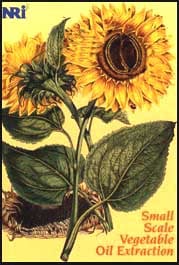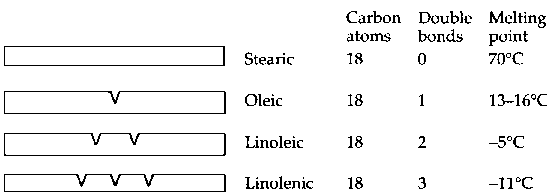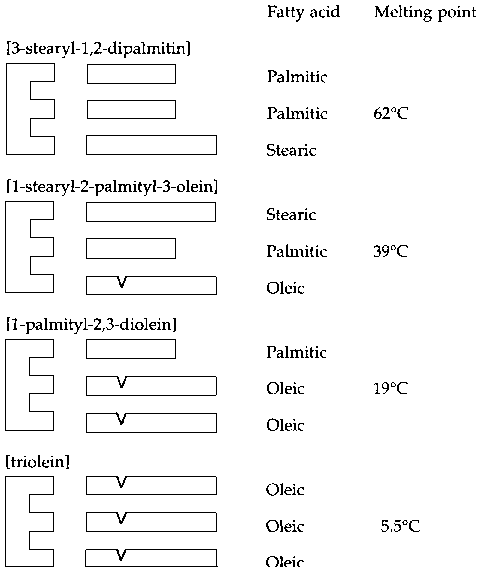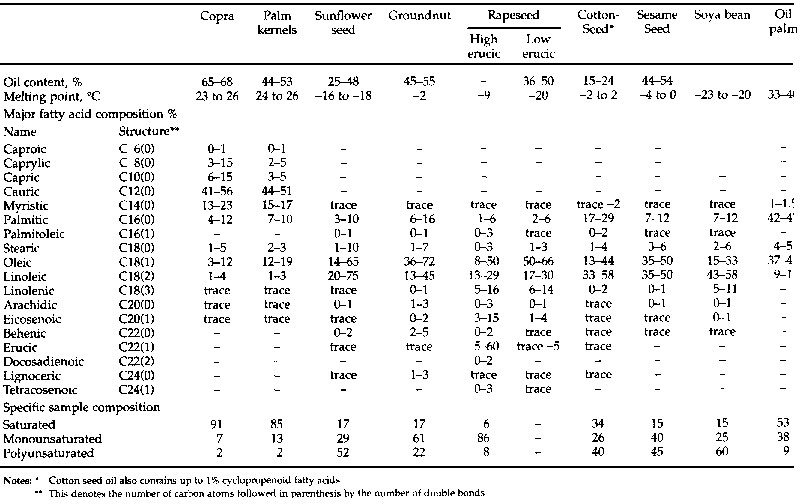
Chapter 1 - Oilseed composition[edit | edit source]
This section is intended to provide the reader with a basic understanding of the composition of oils and fats, and to define many of the terms used in their processing. A complete understanding of its content, although desirable, is not essential.
Oilseeds can be thought of as mixtures of oil, meal and water. Processing removes the bulk of the oil and the product remaining is called oil-cake. Oil-cake contains the residual oil, all of the meal and some water. Since the meal is mainly composed of protein, carbohydrate and fibre, oilseed-cakes in general are excellent materials for animal feeds. Table 1 shows the composition of copra (dried coconut kernel) by weight and weight percentage terms at various levels of moisture content.
|
Composition by weight |
% Composition | ||||||
|
Oil |
Meal |
Water |
Total |
Oil |
Meal |
Water | |
|
Wet copra |
65.0 |
29.0 |
23.5 |
117.5 |
55.3 |
24.7 |
20.0 |
|
Underdried copra |
65.0 |
29.0 |
12.8 |
106.8 |
60.9 |
27.1 |
12.0 |
|
Dry copra |
65.0 |
29.0 |
|
100.0 |
65.0 |
29.0 |
|
|
Copra (moisture free) |
65.0 |
29.0 |
|
94.0 |
69.1 |
30.9 |
|
Copra is usually considered to be dry when its moisture content is 6%. A typical oil content of dry copra is 65%, leaving a balance of 29% for the meal contenttokkemanna kadu1 show the changes in oil and moisture content as a sample of copra dries out. The figures are composed so that the weight of 'dry' copra is 100 parts. Thus, 117.5 kg of wet copra containing 55.3% oil and 20% water will dry down to 100 kg of 'dry' copra containing 65% oil and 6% water. In other words, 100 kg of copra at 20% moisture only contains 55.3 kg of oil whereas 100 kg of 'dry' copra will contain 65 kg.
Because of the variation of oil content with moisture content, comparisons of oil contents are always made on a dry weight or 'moisture free basis' (MFB). The oil content of copra (MFB) in Table 1 is 69.1%. The following formula may be used to convert oil content (MFB) to oil content at any given moisture content:
% oil (at x% moisture) = % oil (MFB) multiplied by (100-x) / 100
Thus, if the oil content of groundnuts (MFB) is 50%, then the oil content at 10% moisture is:
50 x (100-10) / 100 =45%
Extraction efficiency[edit | edit source]
Extraction efficiency (EE), an important quantity in oilseed processing, is the percentage of oil extracted in relation to the amount of oil present in the seed. If 100 kg of sunflower seed (oil content 32% MFB) are processed to yield 29 kg of the oil, then the extraction efficiency is:
29 x 100 / 32 = 90.6%
Extraction efficiency tends to be related to the oil content of the seed. It is difficult to achieve high levels of efficiency with seed of low oil content. However, in general, large-scale processing operates with an EE of over 90%, whereas in small-scale processing, EE is usually in the range 60-65% and rarely exceeds 80%.
Oils and fats - origin and definition[edit | edit source]
Oils and fats are basically similar in composition. They are substances used by plants and animals mainly as an energy store. Some of their components are essential to metabolic processes. Many seeds are rich in fats which act as a food supply to the young seedling. The difference between an oil and a fat is that an oil is usually liquid at ambient temperature while a fat is solid. However, this simple definition can result in anomalies; coconut oil, for example, which has a melting range of 22-24°C, is usually a liquid oil in the tropics but a solid fat in temperate climates.
Triglycerides and fatty acids[edit | edit source]
Oils and fats are obtained from a wide variety of sources and each one has its own individual properties. They are, however, all of the same chemical type. The basis of a fat is a substance called glycerol which has a chemical formula that can be illustrated by the shape shown opposite.
Each of the 'arms' of this shape can combine with another substance known as fatty acid, to build up a molecule rather like the following:
Glycerol
Glycerol and fatty acids
Because of the way in which its composition is built up, the chemical substance having this form is known as a triglyceride, and all oils and fats are made up of a mixture of these triglycerides. A number of different fatty acids exist and, to a large extent, the character of a particular oil or fat depends on the actual fatty acids present in the individual triglyceride molecules. Some of these component fatty acids are longer than others and they can all combine with a glycerol 'arm':
Figure
In addition, there are three different types of fatty acids: saturated, mono-unsaturated and polyunsaturated.
Saturated fatty acids
In their simplest form, fatty acids are made up of a linear chain of carbon atoms linked to a group which provides the acidic properties. Such fatty acids are said to be saturated; the most common examples being lauric, myristic palmitic and stearic acids. These contain different numbers of carbon atoms and can be represented as follows:
Figure
Note that all these acids are solid at normal ambient temperatures and that their presence in high proportions in a triglyceride mixture is likely to make it solid.
Monounsaturated fatty acids
Sometimes the carbon atom chain contains what chemists call a double bond. A fatty acid containing one double bond is said to be monounsaturated, the most common example being oleic acid which, like stearic acid, has 18 carbon atoms.
Polyunsaturated fatty acids
Some fatty acids have two or three double bonds and these are said to be polyunsaturated fatty acids. Linoleic and linolenic acids are common examples of polyunsaturated fatty acids. They have the same number of carbon atoms as stearic acid, but linoleic acid has two double bonds and linolenic acid has three. The relationship between the common fatty acids with 18 carbon atoms (C18 acids) can be represented as follows:
Figure
It can be seen that the presence of a double bond lowers the melting point. Thus, a triglyceride mixture containing a high proportion of monounsaturated or polyunsaturated fatty acids is likely to be liquid.
Structures of some specific triglycerides
The following triglycerides are just some of the many that are found in palm oil.
Figure
The overall triglyceride composition is such that palm oil is liquid or semisolid at tropical temperatures but solid in temperate climates.
Fatty acid composition
Analytical chemists are able to measure the overall proportions of the different fatty acids present in an oil or fat. The fatty acid composition of the oil tends to be characteristic of the oilseed from which it is extracted. The fatty acid compositions and melting points of oils from different oilseeds are given in Table 2, together with the oil contents of the seeds.
Table 2 Typical oil contents, melting: points and oil composition of selected oilseeds
Triglyceride deterioration and free fatty acids
Oils and fats generally keep quite well, but the following two types of deterioration can occur under poor storage conditions: oxidation, when the fat is attacked by the oxygen present in the air; and hydrolysis, when the fat is attacked by water. Usually hydrolysis occurs in the presence of an enzyme which either exists naturally in the oilseed, or is present in moulds which grow on it.
Oxidation
Oxygen in the air usually attacks the triglyceride close to the double bonds in the fat.
Figure
Thus, fats with few double bonds are more stable than fats with a large number of double bonds. The process of oxidation in oils and fats is accelerated by the presence of trace metals such as iron and copper. Mild steel equipment is frequently used in oilseed processing and should be kept free from rust as far as possible. Brass and copper induce a much more powerful oxidizing action than iron and so fittings made from these metals should never be used.
Hydrolysis and free fatty acids
Attack by water in the presence of an enzyme splits the fatty acid away from the triglyceride. Eventually, glycerol and free fatty acid (FFA) will be obtained, but intermediate stages, where only one or two of the fatty acids have been split away from the triglyceride, will also be present in the fat.
Figure
Hydrolysis can occur both in oilseeds and in extracted oil. Hydrolysis in oilseeds is accelerated by the presence of moulds. It is therefore very important to dry oilseeds to a moisture level which does not encourage mould growth.
The level of FFA in an oil extracted from a good quality oilseed is very low and so FFA content is used as a guide to the extent of deterioration in the quality of oils. Coconut oil from high quality copra can have FFA levels in the region of 0.1 to 0.2%, but levels as high as 5% can occur in oil from poor quality copra. Even good quality oil will deteriorate quickly if it contains oilseed residues or is stored in wet drums. To avoid deterioration, particles of seed debris should be removed from the oil as soon as possible after extraction and the clarified oil stored in clean dry containers.
Acknowledgment
The authors wish to thank Peerless Food Products, a division of Pura Food Products Ltd, UK, for permission to use their pictorial concept of triglyceride structure in this publication.








